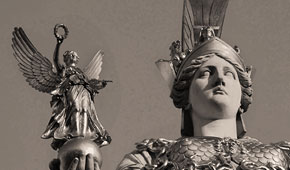Although the Salem Athenæum’s charter and name date from 1810, its history actually begins fifty years earlier with the founding of two earlier institutions: the Social Library in 1760; and the Salem Philosophical Library in 1781.
The Social Library was an outgrowth of the Monday Evening Club, one of many social clubs for wealthy residents that were common in the era. The Monday Evening Club counted among its members many of Salem’s most prominent merchants, lawyers, and religious leaders and other members of Salem’s cultural elite.
In 1760 a group of Club members donated 175 guineas toward the foundation of a library for their mutual use. The new Social Library was stocked both by donations from members’ own libraries and by new purchases from London booksellers. Membership was not technically restricted as long as applicants could meet the £11 yearly cost (approximately $1500 in current dollars).
The Revolutionary War took a heavy toll on the Social Library. The cost of living soared, as goods were difficult to attain, and most members were preoccupied with the war and protecting their own interests. A number of members were loyalists and fled Salem altogether.
The Philosophical Library was founded in 1781 from the spoils of war. The ship Pilgrim, a privateer sailing out of Beverly, captured the Duke of Gloucester, the first of her nine valuable prizes, on September 5 in the Irish Channel. The Duke of Gloucester had sailed for Bristol from Galway that same day with a load of kelp and the library of Richard Kirwan (1733-1812). Kirwan had recently been elected a Fellow of the Royal Society for his research in chemistry, and anticipated re-locating indefinitely from his family estate, Castle Cregg in County Galway, to London. His library was captured with the ship and the 116 volumes were transferred to the Pilgrim and subsequently auctioned on April 12, 1781 in Salem.
Reverend Joseph Willard of the First Church in Beverly learned of the Kirwan library and gathered a group of associates to pool resources to purchase the lot. Organized as the Philosophical Library, the volumes were circulated to members and remained at Willard’s residence in Beverly until he was elected President of Harvard College, at which time the collection was transferred to Reverend John Prince at the First Church, Salem. Over time, members added the latest scientific works and serials, increasing the collection threefold. The costly serial subscriptions kept the annual assessments high, and were a contributing factor to the eventual decision to merge with the Social Library to form the Salem Athenæum.
By 1810, many of the members of the Social Library also belonged to the Philosophical Library, and the two bodies were merged to create the Salem Athenæum. When the Athenæum was founded, there were more libraries in Salem then there were in Boston. This gives some hint as to the prominence of Salem at the time as a center of culture and learning. In addition to the Philosophical library and the Social Library, there were also the Library of Arts and Sciences, the Fourth Social Library, and the extensive holdings of maritime information, artifacts and curiosities at the Essex Institute.
The very name “Athenæum” is an artifact of that era, deriving from “Athena,” the Greek goddess of wisdom. Its early members, as with the two previous institutions, were men and women of the Enlightenment who aimed to increase each other’s knowledge and to pursue the improvement of society and themselves through its application and dissemination.
For the first four decades of its existence, the Athenæum had no permanent home, occupying quarters at four different locations in Salem. In the 1850s, a bequest from Caroline Plummer enabled the Athenæum to erect a brick building in the Italianate style at 132 Essex Street which was its home for fifty years.
In 1905, the Athenæum sold the building at 132 Essex Street to the Essex Institute (now the Peabody Essex Museum), and with the proceeds constructed the building it currently occupies, at 337 Essex Street. Dedicated in 1907, this handsome red brick structure was modeled on Homewood, an estate in Maryland built by Charles Carroll (a signer of the Declaration of Independence) for his son.
Today the Athenæum is home to over 50,000 volumes in its circulating and research collections and the welcoming reading room and garden offer opportunities for quiet work as well as a host of cultural programs including concerts, readings, lectures, performances, and lively social gatherings.
Prominent members and patrons of the Athenæum have included Edward Augustus Holyoke, physician and a founder of the American Academy of Arts & Sciences, the Reverend Dr. William Bentley, author Nathaniel Hawthorne, mathematician Nathaniel Bowditch, author of the still-used New American Practical Navigator, United States Supreme Court Justice Joseph Story, American Impressionist painter Frank W. Benson, and Charles Grafton Page, an early inventor of the electric motor.
Since 2017, The Salem Athenaeum has been the primary presenter of Salem Literary Festival at the invitation of best-selling author and Salem resident, Brunonia Barry. Cornerstone Books started Lit Fest in 2008 and Barry had been presenting since 2014 following the closure of the bookstore. The Salem Literary Festival Committee is comprised of librarians, writers, and passionate readers who are committed to celebrating literature in all forms, honoring Salem’s own literary heritage, and fostering the next generation of readers and writers.
Upcoming Events
-
Dec. 25:
Closed for Winter Break
December 25–January 1 - Jan. 15:
-
Jan. 22:
Writers and AI: What You Need to Know
7:00 p.m. -
Jan. 24:
New Members Event
10:00 a.m.–12:00 p.m.
